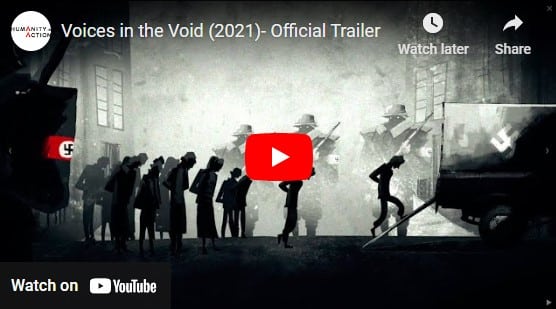Ghetto Fighters’ Museum, USC Shoah Foundation Bring Lessons of Courageous Danish Rescue Operation to Classrooms
Voices in the Void – The flight and rescue of the Jews in Denmark

Middle and high school students around the world are exploring the themes of resistance, solidarity and resilience using an innovative new film-based curriculum produced by the USC Shoah Foundation and The Ghetto Fighters’ House Museum in Israel, one of the first Holocaust museums in the world.
The classroom activity, “Voices in the Void: The Flight and Rescue of the Jews in Denmark,” uses an animated short film to tell the story of the 1943 rescue of 7,000 Danish Jews smuggled to Sweden on fishing boats in an operation that involved Danes from all sectors of society, ranging from King Christian X to priests and cab drivers. A series of thought-provoking questions encourages students to explore the values and beliefs that shaped the motivations and decisions of those involved.
In addition to the 18-minute film and a teachers’ guide, the activity includes a short video on the history of Danish Jewry and a clip from the Visual History Archive testimony of Arne Christiansen, a Danish rescuer and aid provider.
The content is available on the Ghetto Fighters’ House educational website, free of charge, in English, Hebrew, Arabic and Danish, and on IWitness, the USC Shoah Foundation’s educational platform that is accessed by more than 41,000 educators and hundreds of thousands of students around the world.
“Voices in the Void” marks the first collaboration between two of the world’s leading organizations committed to Holocaust education.
The USC Shoah Foundation, which holds the world’s largest video collection of Holocaust survivor testimonies, produces educational content that, thanks to collaborations and partnerships, reached an estimated 11.8 million students in 2022.
Some 80,000 visitors experience the interactive, docent-led tours of the Ghetto Fighters’ House on a kibbutz in northern Israel every year.
The museum was founded in 1949 by Holocaust survivors, including some who fought in and led the April 1943 Warsaw Ghetto Uprising. Since the COVID-19 pandemic lockdown, the museum has ramped up its online offerings, including the “Voices in the Void” workshop.
With guidance and support from the Danish Embassy in Tel Aviv and the Danish Jewish Museum in Copenhagen, the Ghetto Fighters’ House developed educational content around the film and later collaborated with the USC Shoah Foundation to adapt it for IWitness.
Andrea Szonyi, Head of Programs for International Education at the USC Shoah Foundation, said that working with the Ghetto Fighters’ House to adapt “Voices in the Void” for IWitness was collaboration at its best.
“We each came in with our own approach and our own methodology, and through the collaborative process we produced something engaging and impactful,” Szonyi said.
Yaron Tzur, Pedagogic Director of the Ghetto Fighters’ House, said tapping into the expertise of the USC Shoah Foundation enabled his team to stretch the limits of their own platform.
“This is a very organic collaboration, because we are two organizations who both strive to help students develop critical thinking skills, and to inspire them to become civically engaged and socially responsible,” he said.
Tzur recently presented a “Voices in the Void” workshop to representatives from Danish embassies around the world, and in October the Ghetto Fighters’ House plans to host a student and educator webinar in honor of the 80th anniversary of the rescue. The museum also plans to bring together classrooms from Israel, Denmark, Germany, and the United States in an online collaboration.
“Voices in the Void”–one of a trilogy of Holocaust-era films produced by Humanity in Action–was selected for several film festivals and received honorable mention at the Copenhagen Film Festival in 2021.
The animated film, rendered mostly in black and white with splashes of color, explores the events of 1943 through the eyes of 10-year-old Bent Melchior, who later became the Chief Rabbi of Denmark. Melchior’s testimony, recorded in 1997, is contained in the Visual History Archive.
Melchior narrates the film, recalling the day in the fall of 1943 when his father, Rabbi Marcus Melchior, was warned by a sympathetic German that Gestapo raids would commence throughout Nazi-occupied Denmark immediately after Rosh Hashanah (the Jewish New Year). At a special service at his Copenhagen synagogue, Melchior’s father managed to secretly convey a message to his congregants: They had 48 hours to flee.
Moving quickly, Danes helped hide their Jewish neighbors. Melchior’s family found refuge with a priest. Over the next few weeks, taxi cabs and wagons transported Jews to the coast, where fishermen loaded them into the holds of their boats and brought them to neutral Sweden, which had opened its doors to refugees. In the film, Melchior remembers a Swedish family waving them towards the shore after their boat went astray.
About 95 percent of the Jewish population in Denmark were smuggled out of the country, and many, including Melchior, returned after the war. Melchior’s father later became Chief Rabbi of Denmark, a position that Bent also subsequently held. Bent’s son, Rabbi Michael Melchior, served as a minister in the Israeli government, and his grandson, Rabbi Yair Melchior, is now the Chief Rabbi of Denmark.
In the “Voices in the Void” workshop, students are asked to consider this history and its relevance to their lives today, and to reflect on the words of Rabbi Bent Melchior, who died in 2021.
“I think the moral is that you have to listen to your conscience. If you feel that there is something to do, don’t say, ‘Well, let others do it,’, but do it yourself. Make the difference.”
Access the “Voices in the Void” classroom activity at IWitness or the Ghetto Fighters’ House Museum.
Read Storyteller in Residence Rachael Cerrotti’s tribute to Bent Melchior.




